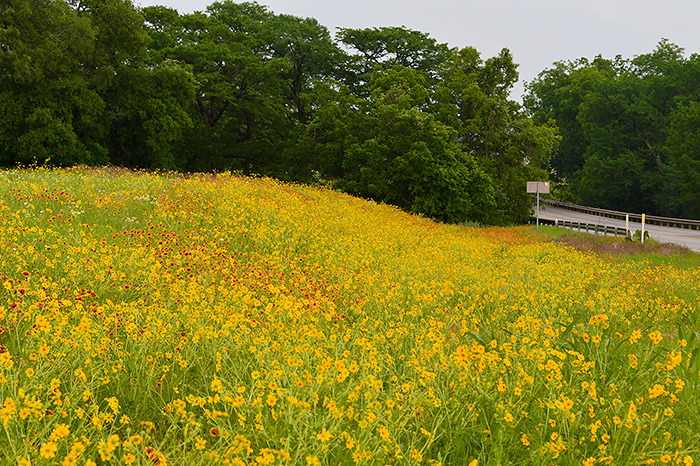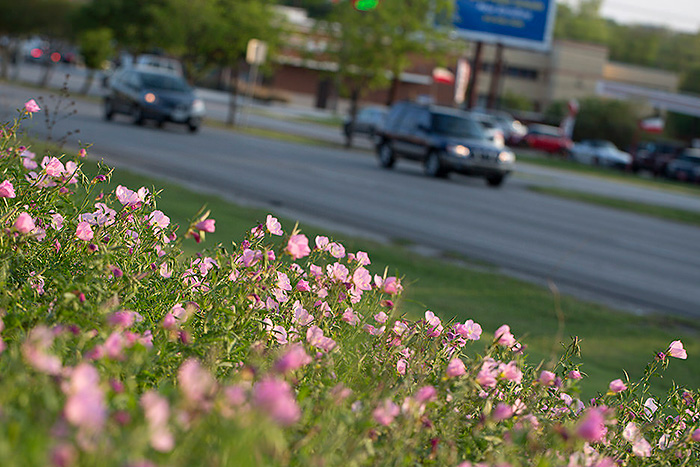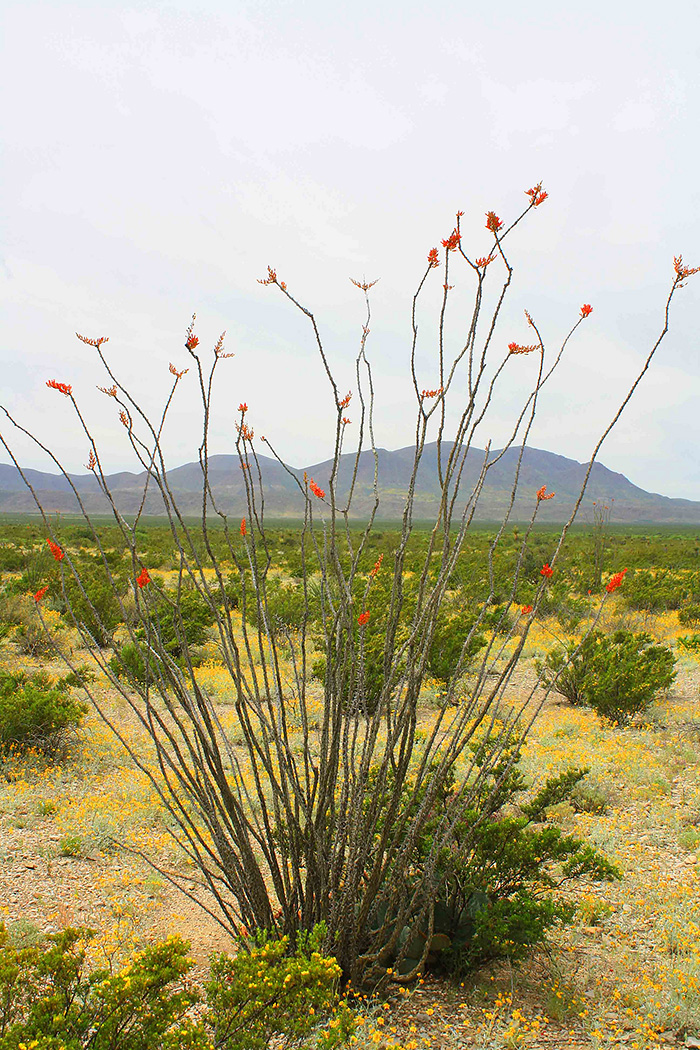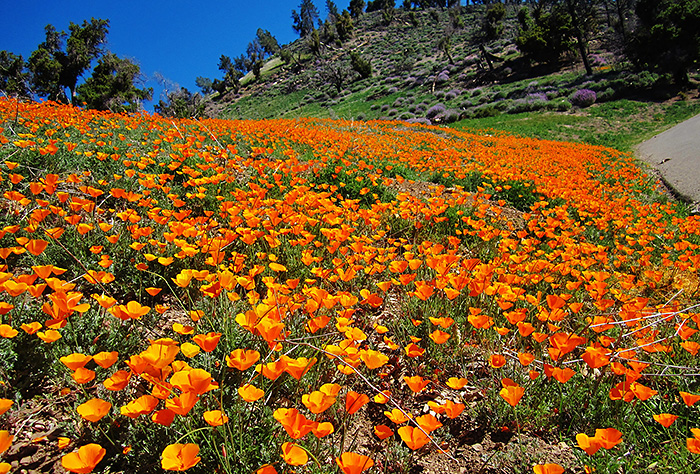The Scenic Route

Lanceleaf coreopsis (Coreopsis lanceolata) and Indian blanket (Gaillardia pulchella) alongside Loop 337 in New Braunfels, Texas. Pollinators rely on habitat like this that exists on the 17 million acres of roadside across the country. PHOTO Courtney Lykins
THE ALARMING LOSS OF HABITAT over the past two decades has left untold millions of bees, butterflies and other wild pollinators hungry and homeless. The small creatures on which we depend for a significant portion of our food supply have hardly been without their champions; public support for monarch butterflies alone has been estimated in the billions of dollars. Still, the pollinator prognosis remained dire. But over the past 18 months, support for pollinators has undergone a seismic shift, led by President Obama, who called for a national Pollinator Task Force in the spring of 2014. Less than a year later, in a book-length “Strategy to Protect the Health of Honey Bees and Other Pollinators,” the federal government set ambitious goals that include the restoration or enhancement of 7 million acres of land for pollinator habitat over the next five years. Roadsides will comprise a significant portion of that acreage.
“It’s historic,” says Scott Black, executive director of the Xerces Society for Invertebrate Conservation. “Two decades ago, we could have fit all the people who were interested in this topic in my dining room. It’s incredible that the President has become involved. It’s a major advance in pollinator conservation.”
Why are roadsides so important? Because they offer the space to support the wide variety of the wildflowers and other native plants essential to pollinator survival – as anyone can observe on a summer stroll along a quiet country lane. But many people would be surprised to learn how vast our roadside acreage really is.
“Roadsides form one of the most extensive linear habitats on earth,” says Jennifer Hopwood, a senior pollinator conservation specialist with the Xerces Society. Federal or state highway agencies manage more than 17 million acres of roadside lands – not counting the thousands of miles of additional roadways maintained by our national parks and forests. In many areas, due largely to development and agricultural practices, pollinators have nowhere else to go.
“Roadsides that pass through urban areas and intensely farmed landscapes often provide the only natural or semi-natural habitat in the vicinity,” Hopwood adds.
For the most part, this is public land, often ignored or abused, that, with caring management, can help our beleaguered pollinators begin to thrive once more. Many factors, some yet to be identified, have contributed to the collapse of wild pollinator populations. But an overarching cause is loss of safe habitat – something roadsides don’t always currently provide, even in the remote countryside. Safe habitat is pesticide and herbicide-free. It includes not only the plants that provide nectar (carbs) and pollen (protein) but also host plants for reproduction, rest stops for migrators and nesting areas for full-time residents, like the ground-nesting bees that often settle in the sunny bare patches between clumps of native grasses. Take away the plants and the pollinators are done for. This is what’s happening at an alarming rate due to development, new agricultural norms and roadside management policies that favor a crew-cut landscape.

Evening primrose plants such as this Oenothera speciosa are insect-pollinated, typically by moths. PHOTO John W. Clark
“We are losing grasslands at the rate of 5 percent a year,” says Hopwood. “That’s comparable to the rate of deforestation in South America.” Every minute, 4 acres of open space is lost to development in the U.S. In this environment of scarcity, roadsides managed as pollinator habitat can be a huge part of the solution – especially for key declining species like bumblebees and monarch butterflies.
Roadside pollinator communities can be quite diverse, including “generalists” (like bumblebees) that forage on a wide variety of flowers, as well as “specialist” species like the monarch butterfly, which lays its eggs only on milkweed. Once abundant on roadsides, milkweed has been disappearing – most significantly along the monarch’s major flyway in the agricultural heart of the country, where it once flourished in fallow fields, between crop rows and along every roadside. “Today fallow fields are quickly disappearing, and crops are planted road to road,” says Karen H. Clary, Ph.D., conservation program manager at the Wildflower Center. Clary is part of a public/private team working to bring back native milkweeds around the Minnesota-to- Mexico l-35 corridor. The disappearance of milkweeds has corresponded with the precipitous drop in the monarch population that has put the iconic butterfly on a federal watch list.
Roadside Plants Help Keep Ecosystems Intact
Bumblebees, increasingly regarded as vital to our food supply, also help sustain ecosystems in which many animal species forage through their pollination of wildflowers. But insects aren’t the only pollinators we rely on. In parts of the Southwest, agaves and certain cactuses pollinated by nectar-eating bats are the primary vegetation, essentially holding the regional ecosystem together. But as these plants are harvested in growing quantities for use in mescal and tequila, they’re becoming scarce in many areas, and their presence on roadsides is increasingly important.
A wide range of roadside plants aid migrators like monarchs and hummingbirds by providing stopovers for a sip of nectar and a rest between fragmented habitats. Many hummingbird species make migratory journeys that equal or exceed the monarch’s annual 2,000 to 3,000 miles. For sustenance along the way, they’ve depended on nectar corridors, established over such long periods of time that they’ve developed a mutualistic association with the plants they feed on. At least 129 native plant species are known to be pollinated by 11 different hummingbird species in western North America. Appropriately managed roadsides can help keep these plants growing and sustain their pollinators, all of which are threatened to varying degrees.
What We Need to Do and Stop Doing
“One of the key considerations is the presence of native plants,” says Hopwood, who is part of the Xerces Society team working with environmental consulting company ICF International (under contract with the Federal Highway Administration) to establish best management practices for roadsides.
A variety of native plants, blooming from spring through fall, are vital both in terms of number of pollinator species the habitat will support and ease and cost of maintenance – two primary concerns of the highway managers who will implement the guidelines.
But it’s not simply about planting “the right” flowers. “Everyone immediately goes to the idea that we need to plant more plants. First, we need to look at our existing resources and how we can manage and use them,” says Black.
One might well ask why roadsides with existing native habitat can’t simply be left alone. And in some places, reducing or adjusting mowing schedules is all that’s needed to restore a pollinator-friendly roadside. “When states like Texas start looking at their roadsides, they see they have a lot of good habitat already in place,” adds Black.

Ocotillo (Fouquieria splendens) is pollinated by insects and birds. Unethical harvesting of these hardy desert plants by the horticultural trade has put pressure on wild populations of the plant, such as those on roadsides. This one is photographed within Big Bend National Park. PHOTO Bonnie Stanley
Black’s one complaint about the government’s report is its position on pesticides, which essentially just calls for more study. “Study after study has shown that certain products are highly toxic to pollinators and that they are systemic and persistent, with an ecosystem effect,” he says, leading a chorus of well informed voices in asserting that the Strategy should have included decisive action by the EPA.
Obviously, departments of transportation that manage roadsides on federal, state and regional levels have their own mission. The Xerces Society believes that pollinator support and roadside management goals can be quite compatible. Cost is often cited as a disadvantage of planting or restoring native habitat, but studies have shown that though the initial cost of native vegetation may be higher than planting turf, for example, native plantings can save money over time in a number of ways.
Why Native Plants Are Best
One advantage locally native plants have over introduced species (and other natives outside of their traditional range) is experience. “They’ve evolved through enough droughts over time that they’re really good at finding sources of water and nutrients in that particular environment and using it efficiently,” Hopwood explains. “By enabling water to infiltrate much more deeply into the plant’s system, they can reduce runoff,” she adds. Accustomed to competing with the local weeds, they’re more likely to resist invasion from noxious species. (One example: A Wildflower Center study showed that overseeding with native Gaillardia pulchella reduces invasion by introduced bastard cabbage).
All of this means less time, money and energy for transportation departments. But there are challenges in persuading some roadside managers to see it that way. “The classic roadside maintenance idea is turf: neat grass, rather than messy wildflowers,” says Hopwood. “Particularly in urban areas it’s more acceptable to have highways maintained as turf.” Even the word “wildflowers” can be a problem. Bonnie Harper-Lore, one of the first administrators to bring an ecological approach to roadsides, discovered this in the 1980s.
“I think we made a mistake by using the term ‘wildflowers’ because it evoked a negative response among engineers, who were the decision makers,” recalls Harper-Lore, who recently retired from the Federal Highway Administration, where she directed the vegetation management program. “Wildflowers evoked something superfluous. The maintenance districts regarded ‘wildflowers’ as something weedy and uncontrollable.
Even Mrs. Johnson commented some years later that we should have used a different word. I ultimately wished I had introduced the use of native grasses first and then slowly injected native wildflowers or forbs…it would have been an easier sell.”
One of the hardest sells, and one of the most important, is getting state and regional roadside managers to consider reducing or changing mowing regimens that can quickly turn rich habitat into wasteland – at least from a pollinator’s point of view.
“Both the time of year and the frequency of mowing have ecological consequences,” says Hopwood. “Mowing once a year in late autumn when pollinators are not flying, or mowing every few years, would have the least impact.” When mowing is done after plants have gone to seed, they’ll reseed themselves, saving on maintenance costs. And clearly, less frequent mowing is a budget booster.

California poppies (Eschscholzia californica) abloom in Santa Barbara County, California, alongside Figueroa Mountain Road. PHOTO Leslie McCroddan
But, not inappropriately, transportation departments see driver safety as their first priority and say their mowing regimens are based on improving driver sightlines, providing a shoulder, preventing woody vegetation from encroaching and reducing collisions with deer. But Hopwood counters, “Mowing a narrower strip can meet these objectives and leave plenty of habitat.”
Limited studies have failed to show that vegetation taller than turf increases deer-related collisions. Also, as Harper-Lore has pointed out, deer prefer tender new growth; more mature (less frequently mowed) vegetation would be tougher and therefore less appealing to browsers.
While some transportation departments such as Florida’s have cooperated with – and even initiated – pollinator-friendly policies, others remain intransigent about sticking with what’s familiar. However, Xerces Society staff have been encouraged by highway personnel who are excited by the opportunity to be part of a significant conservation effort. “The people on the ground are going to drive change,” says Black. “They will lead by example. Many highway agencies are trying to step up. The government Strategy is going to help; it already has. As managers implement these guidelines, the next county will see it and see that it can be done within their budget.
It will radiate out. Our job is to empower those who want to do the right thing by giving them the tools to do it.” departments do and don’t do. Safe habitat must, first and foremost, be pesticide- and herbicide-free. Numerous conservation groups, including the Wildflower Center, the Xerces Society, Friends of the Earth and the Center for Biological Diversity, assert that bees and other pollinators are poisoned routinely by widely used pesticides already banned in Europe. In agricultural areas, herbicides have destroyed host plants such as milkweeds by the millions.
Black points out that in most places where glyphosates (the most common class of herbicide) are used, they’re used on crops that have been genetically modified to be resistant to the herbicide. “This must be addressed,” he says. “We also need to look over the fence. If a landowner next door is using pesticides, the flowers may look beautiful, but the insects we’re trying to protect will be dead.” In some places, the Xerces Society has found, roadsides are actually being managed not by transportation personnel but by adjacent landowners. “They’ve got the mower out, so they just go ahead and mow, thinking they’re helping their highway people,” says Black. “Education is the key, across the board.”
Lady Bird Johnson once said she wanted the roadsides of Texas to look like Texas, and Vermont to look like Vermont, and so on. Those close to the first lady know she understood that the benefits of native roadsides didn’t end with their distinctive regional beauty and that they were vital to the creatures they support. Ironically, today, as we struggle to better understand and meet their needs, the pollinators are helping to drive the realization of her dream.
Bibi Wein authored the award-winning memoir “The Way Home: A Wilderness Odyssey” (Tupelo Press).
Editor’s note: This article originally appeared in the Fall 2015 Wildflower magazine (Vol. 32, No. 1). It reflects a correction to Scott Black’s statement about glyphosate-resistant crops.

